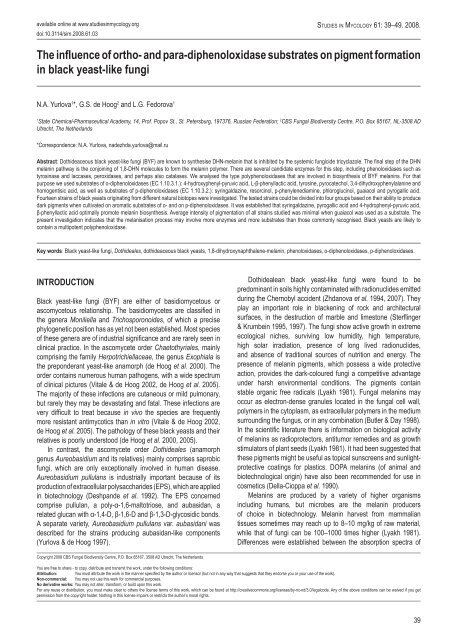You also want an ePaper? Increase the reach of your titles
YUMPU automatically turns print PDFs into web optimized ePapers that Google loves.
available online at www.studiesinmycology.org St u d i es in My c o l o g y 61: 39–49. 2008.doi:10.3114/sim.2008.61.03The influence of ortho- and para-diphenoloxidase substrates on pigment formationin black yeast-like fungiN.A. Yurlova 1 *, G.S. de Hoog 2 and L.G. Fedorova 11State Chemical-Pharmaceutical Academy, 14, Prof. Popov St., St. Petersburg, 197376, Russian Federation; 2 <strong>CBS</strong> Fungal Biodiversity Centre, P.O. Box 85167, NL-3508 ADUtrecht, The Netherlands*Correspondence: N.A. Yurlova, nadezhda.yurlova@mail.ruAbstract: Dothideaceous black yeast-like fungi (BYF) are known to synthesise DHN-melanin that is inhibited by the systemic fungicide tricyclazole. The final step of the DHNmelanin pathway is the conjoining of 1,8-DHN molecules to form the melanin polymer. There are several candidate enzymes for this step, including phenoloxidases such astyrosinase and laccases, peroxidases, and perhaps also catalases. We analysed the type polyphenoloxidases that are involved in biosynthesis of BYF melanins. For thatpurpose we used substrates of o-diphenoloxidases (EC 1.10.3.1.): 4-hydroxyphenyl-pyruvic acid, L-β-phenyllactic acid, tyrosine, pyrocatechol, 3,4-dihydroxyphenylalanine andhomogentisic acid, as well as substrates of p-diphenoloxidases (EC 1.10.3.2.): syringaldazine, resorcinol, p-phenylenediamine, phloroglucinol, guaiacol and pyrogallic acid.Fourteen strains of black yeasts originating from different natural biotopes were investigated. The tested strains could be divided into four groups based on their ability to producedark pigments when cultivated on aromatic substrates of o- and on p-diphenoloxidases. It was established that syringaldazine, pyrogallic acid and 4-hydrophenyl-pyruvic acid,β-phenyllactic acid optimally promote melanin biosynthesis. Average intensity of pigmentation of all strains studied was minimal when guaiacol was used as a substrate. Thepresent investigation indicates that the melanisation process may involve more enzymes and more substrates than those commonly recognised. <strong>Black</strong> yeasts are likely tocontain a multipotent polyphenoloxidase.Key words: <strong>Black</strong> yeast-like fungi, Dothideales, dothideaceous black yeasts, 1,8-dihydroxynaphthalene-melanin, phenoloxidases, o-diphenoloxidases, p-diphenoloxidases.INTRODUCTION<strong>Black</strong> yeast-like fungi (BYF) are either of basidiomycetous orascomycetous relationship. The basidiomycetes are classified inthe genera Moniliella and Trichosporonoides, of which a precisephylogenetic position has as yet not been established. Most speciesof these genera are of industrial significance and are rarely seen inclinical practice. In the ascomycete order Chaetothyriales, mainlycomprising the family Herpotrichiellaceae, the genus Exophiala isthe preponderant yeast-like anamorph (de Hoog et al. 2000). Theorder contains numerous human pathogens, with a wide spectrumof clinical pictures (Vitale & de Hoog 2002, de Hoog et al. 2005).The majority of these infections are cutaneous or mild pulmonary,but rarely they may be devastating and fatal. These infections arevery difficult to treat because in vivo the species are frequentlymore resistant antimycotics than in vitro (Vitale & de Hoog 2002,de Hoog et al. 2005). The pathology of these black yeasts and theirrelatives is poorly understood (de Hoog et al. 2000, 2005).In contrast, the ascomycete order Dothideales (anamorphgenus Aureobasidium and its relatives) mainly comprises saprobicfungi, which are only exceptionally involved in human disease.Aureobasidium pullulans is industrially important because of itsproduction of extracellular polysaccharides (EPS), which are appliedin biotechnology (Deshpande et al. 1992). The EPS concernedcomprise pullulan, a poly-α-1,6-maltotriose, and aubasidan, arelated glucan with α-1,4-D, β-1,6-D and β-1,3-D-glycosidic bonds.A separate variety, Aureobasidium pullulans var. aubasidani wasdescribed for the strains producing aubasidan-like components(Yurlova & de Hoog 1997).Dothidealean black yeast-like fungi were found to bepredominant in soils highly contaminated with radionuclides emittedduring the Chernobyl accident (Zhdanova et al. 1994, 2007). Theyplay an important role in blackening of rock and architecturalsurfaces, in the destruction of marble and limestone (Sterflinger& Krumbein 1995, 1997). The fungi show active growth in extremeecological niches, surviving low humidity, high temperature,high solar irradiation, presence of long lived radionuclides,and absence of traditional sources of nutrition and energy. Thepresence of melanin pigments, which possess a wide protectiveaction, provides the dark-coloured fungi a competitive advantageunder harsh environmental conditions. The pigments containstable organic free radicals (Lyakh 1981). Fungal melanins mayoccur as electron-dense granules located in the <strong>fungal</strong> cell wall,polymers in the cytoplasm, as extracellular polymers in the mediumsurrounding the fungus, or in any combination (Butler & Day 1998).In the scientific literature there is information on biological activityof melanins as radioprotectors, antitumor remedies and as growthstimulators of plant seeds (Lyakh 1981). It had been suggested thatthese pigments might be useful as topical sunscreens and sunlightprotectivecoatings for plastics. DOPA melanins (of animal andbiotechnological origin) have also been recommended for use incosmetics (Della-Cioppa et al. 1990).Melanins are produced by a variety of higher organismsincluding humans, but microbes are the melanin producersof choice in biotechnology. Melanin harvest from mammaliantissues sometimes may reach up to 8–10 mg/kg of raw material,while that of fungi can be 100–1000 times higher (Lyakh 1981).Differences were established between the absorption spectra ofCopyright 2008 <strong>CBS</strong> Fungal Biodiversity Centre, P.O. Box 85167, 3508 AD Utrecht, The Netherlands.You are free to share - to copy, distribute and transmit the work, under the following conditions:Attribution:You must attribute the work in the manner specified by the author or licensor (but not in any way that suggests that they endorse you or your use of the work).Non-commercial: You may not use this work for commercial purposes.No derivative works: You may not alter, transform, or build upon this work.For any reuse or distribution, you must make clear to others the license terms of this work, which can be found at http://creativecommons.org/licenses/by-nc-nd/3.0/legalcode. Any of the above conditions can be waived if you getpermission from the copyright holder. Nothing in this license impairs or restricts the author’s moral rights.39
















